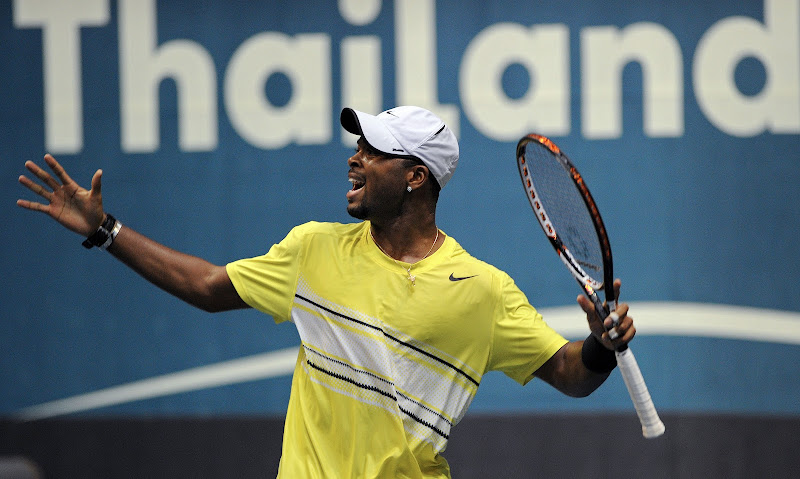By Robert Martin
(October 27, 2011) Thanks to the Summer hard court season Donald Young was able to improve his ranking from No. 128 at the beginning of August, to his current No. 43. Not only did he do this with a new racquet, but with a string that you might not have heard of.
 Playing in Thailand with only a small circular stencil on his strings, many were wondering what the deal was considering that he had changed racquets from Head to Prince. That small stencil was actually for his string sponsorship from a relatively new company named Solinco.
Playing in Thailand with only a small circular stencil on his strings, many were wondering what the deal was considering that he had changed racquets from Head to Prince. That small stencil was actually for his string sponsorship from a relatively new company named Solinco.
Like many other upstart string companies, Solinco focuses primarily on their line of co-polyester strings designed for durability, control, and spin. Of their four co-polyester offerings, each has a distinctive color, and they can be mistaken for other popular strings on tour.
Solinco is not making a quiet entry into the market either, sponsoring various ATP players like Igor Andreev (Barb Wire) and Young (Tour Bite). In addition, they are utilizing a grassroots-style of campaign, providing strings for colleges like USC, UCLA, and Minnesota, among others.
Disclaimer: My current string set up of choice uses Yonex Tour Super 850 in the mains with Yonex Poly Tour Pro 125 in the crosses at 28/26kg. Strings were installed at 25kg as full beds of poly in my Yonex RDiS200.
 Solinco Tour Bite 17
Solinco Tour Bite 17
What Makes It Special: Many strings are utilizing geometric shapes in order to increase the spin potential of the string, and Tour Bite is no exception. What makes it unique is that is one of the few strings that uses a square geometry, and is also extruded so that the edges remain extremely sharp compared to many strings that prefer soft edges.
On Court: Given the style of play of Young, I can tell why he uses the Tour Bite string (in 16 gauge). It is not extremely powerful, but provides a lot of spin and control. The edges of the square shape remained sharp instead of wearing down like many other geometry poly strings. This was also a bit of a negative feature of the string, as they did begin to notch faster than many others. I liked the medium power level of the string and it remained in place well for most of the life.
Closing Remarks: While this is not exactly easy to string, it’s not difficult either. It does take a little more time to ensure that you don’t prematurely burn or begin the notching process. It took about an hour of hitting before the tension settled in for me, but most of all I liked the added spin and control.
 Solinco Barb Wire 17
Solinco Barb Wire 17
What Makes It Special: Barb Wire uses the same die as Tour Bite, but features a few major changes. The first is the co-polyester formulation, which results in a slightly stiffer lower powered string. The second, and most recognizable, is that the four-sided shape is now axially twisted, resulting in the appearance of a rough texture designed for even greater spin.
On Court: It was obvious that this string was designed to have less power, but in exchange I was able to get even better directional control, placing ground strokes in the corners easily. Strangely though, I did not feel that I was getting any extra spin with this string and my already spin-friendly racquet. As good as this string was from the baseline, it left me with a bit of disappoint at the net, where the string lacked touch and getting sharp angles gave me some occasional problems.
Final Remarks: This string is ideal for the power topspin game that has taken over tennis today, providing more than enough control and a large amount of spin from the baseline. It leaves something to be desired in other areas of the court, but overall a very solid string for the baseliner.
Overall I preferred Tour Bite both for its slightly higher power, as well as it having a bit more touch around the net. Spin was comparable with both providing high levels. Durability was good for both strings, with the extra texture of Barb Wire causing it to break an hour before Tour Bite.